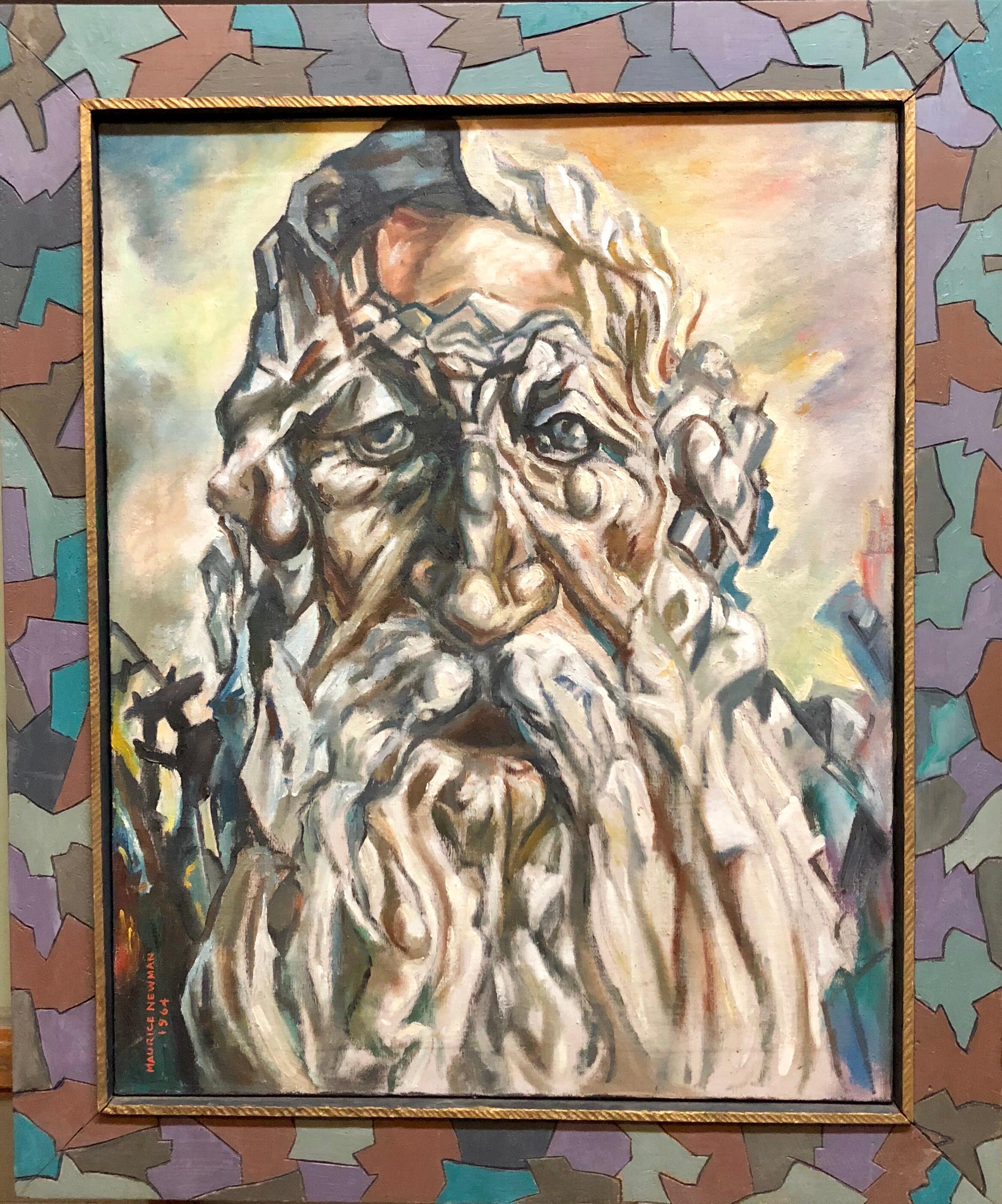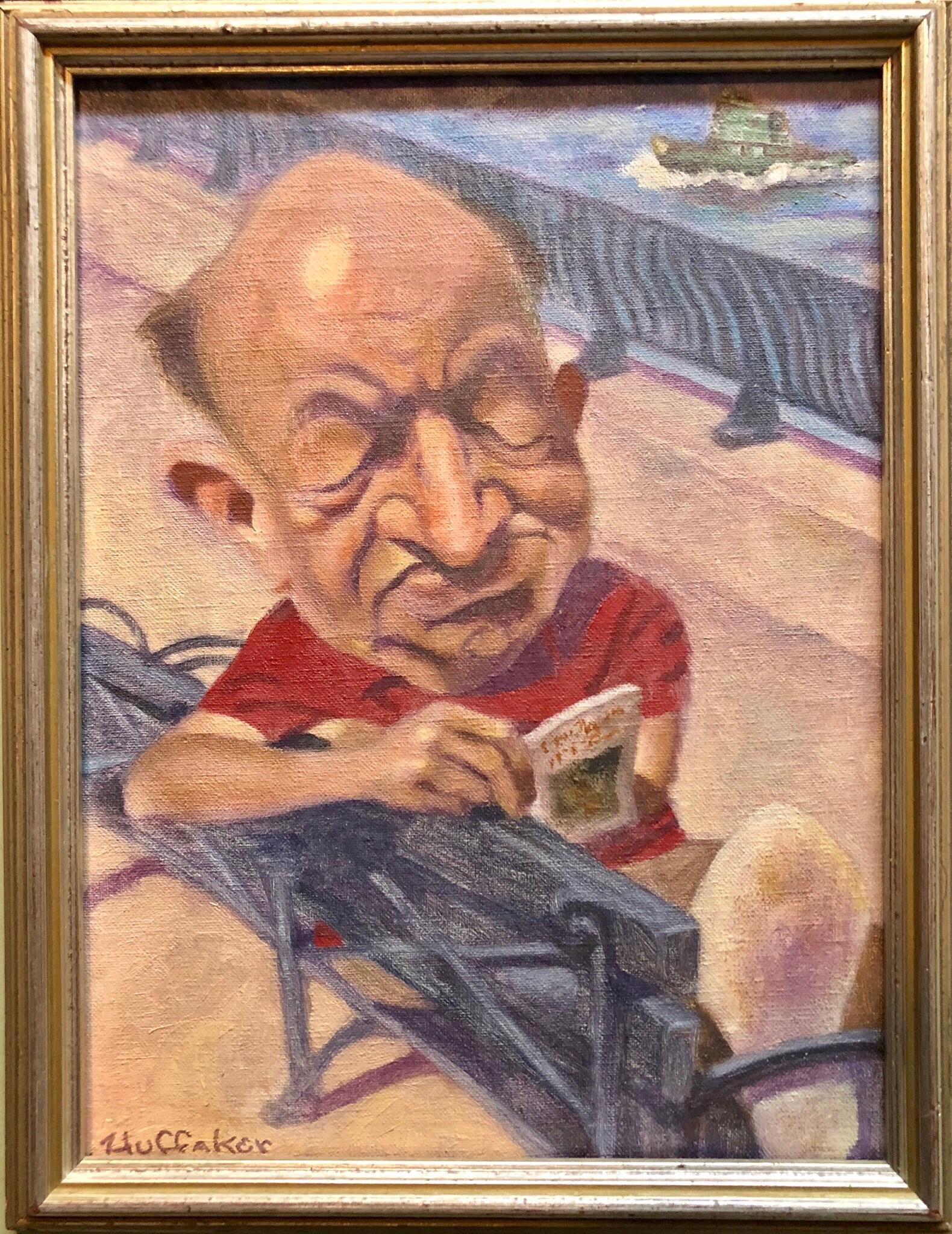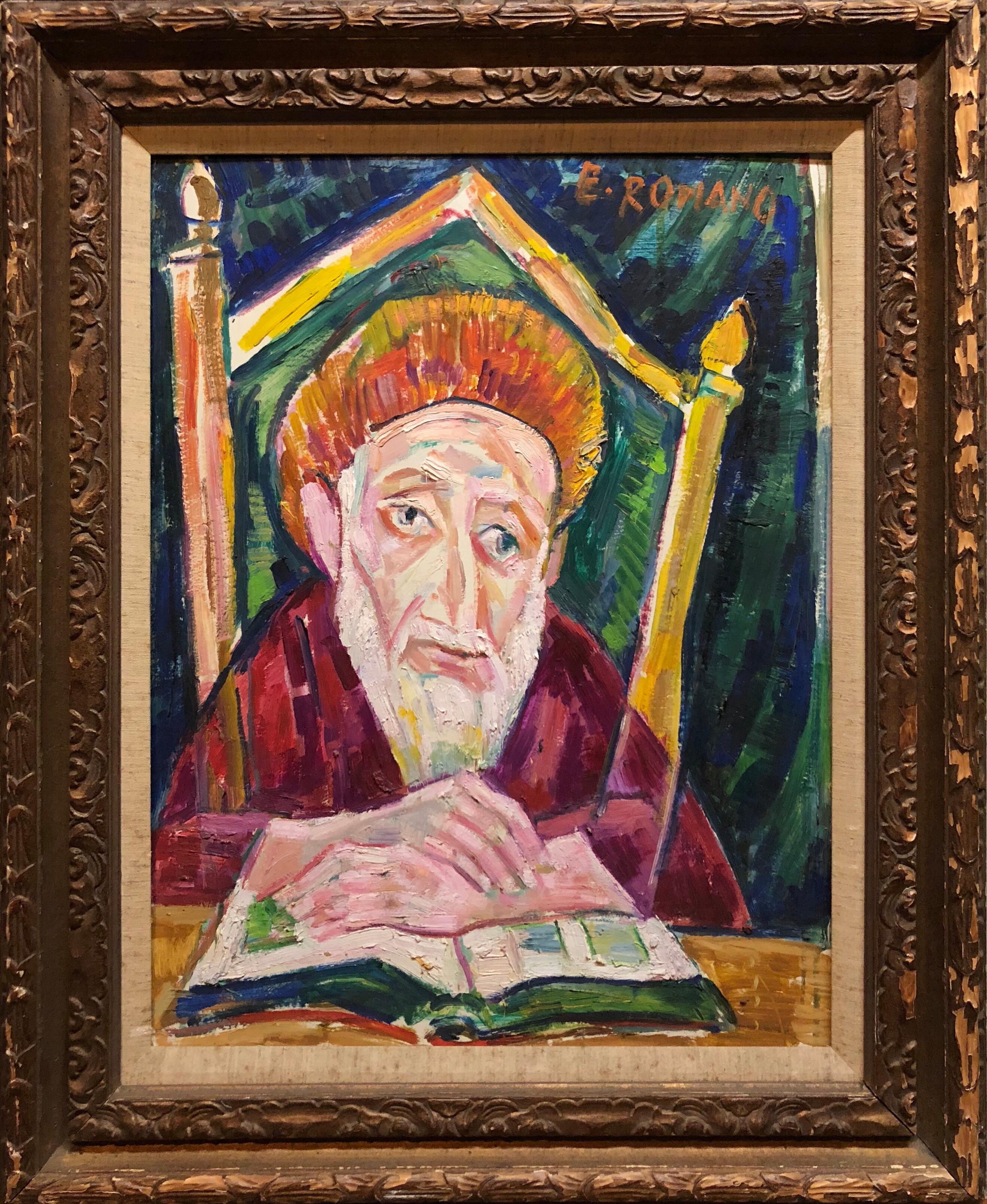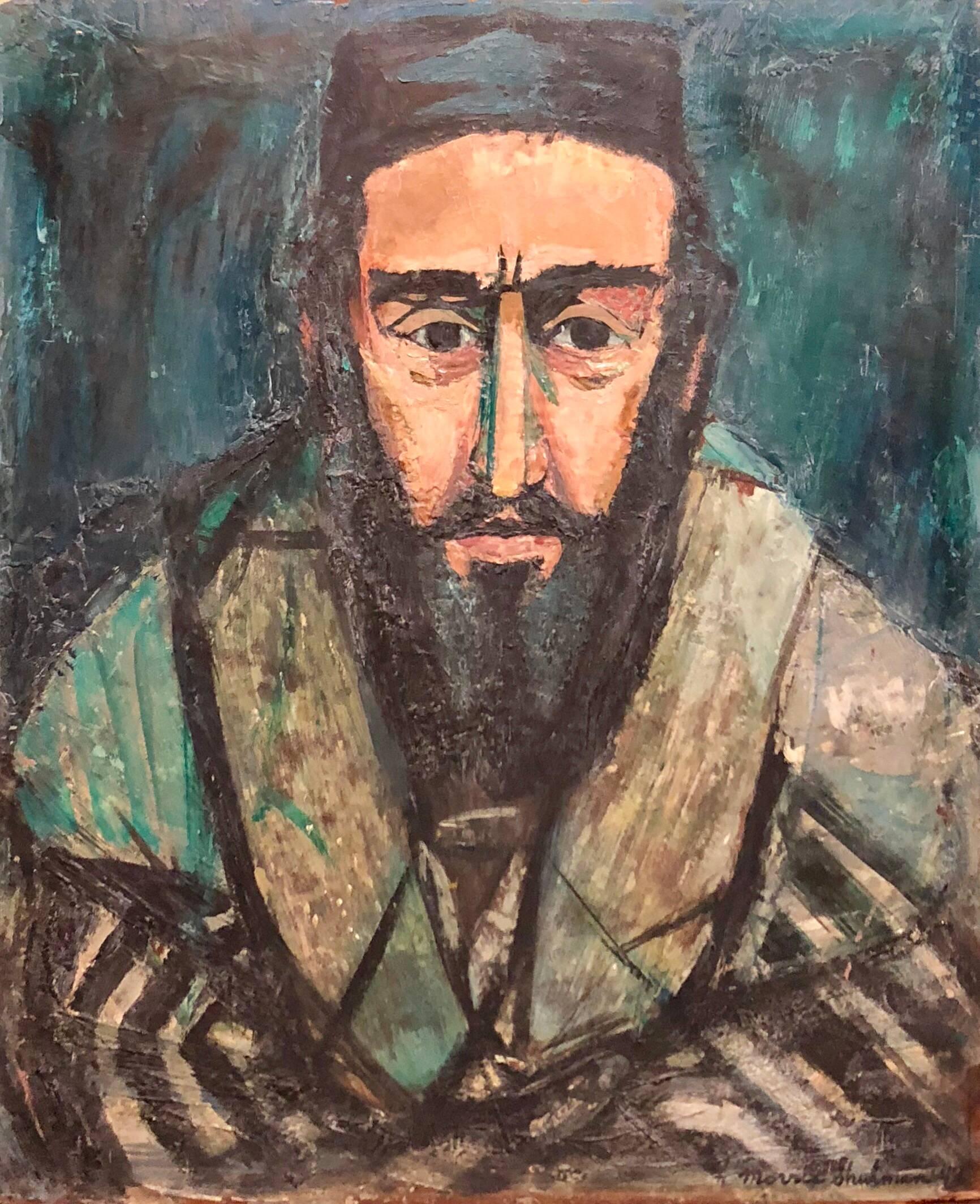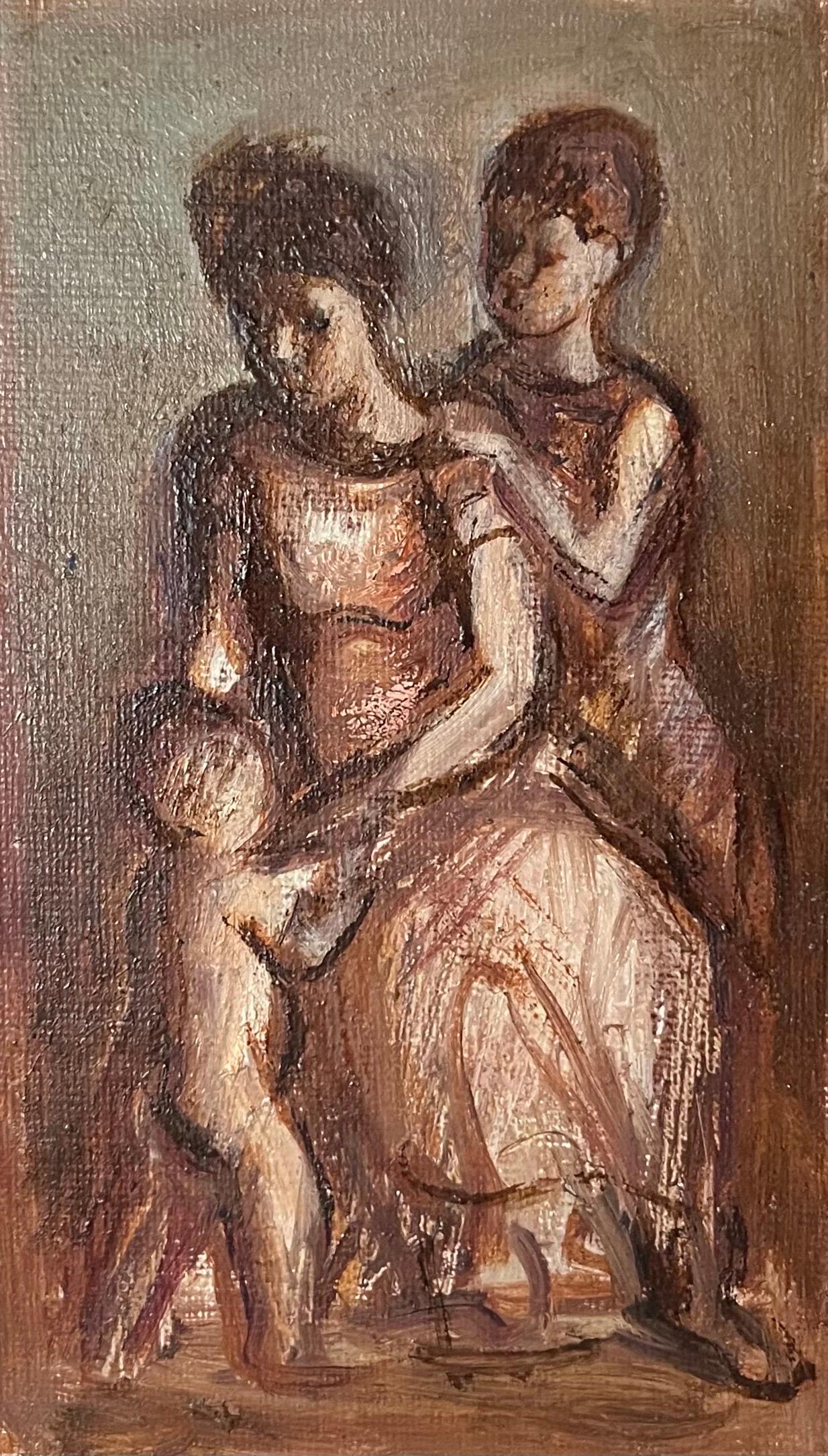Items Similar to Modern Abstract Portrait of a Woman with Child and Fish
Want more images or videos?
Request additional images or videos from the seller
1 of 8
Lynwood KreneckModern Abstract Portrait of a Woman with Child and Fish
About the Item
Modern abstract style painting of a woman fishing. The work is signed by the artist Lynwood Kreneck, who is known for printmaking. The painting is framed in a wooden frame with a silver trim.
Dimensions Without Frame: H 40 in x W 30 in.
Artist Biography: Lynwood Kreneck (born 1936) received his BFA and MFA from The University of Texas at Austin. Kreneck is Professor Emeritus of Art at Texas Tech University, Lubbock, where he taught printmaking for nearly forty years. He is founding curator of the exhibition series Colorprint USA and was instrumental in the development of water-based screen print inks and methods. Kreneck is represented in numerous collections, including the Art Institute of Chicago (IL), Philadelphia Museum of Art (PA), High Museum (Atlanta, GA), Mabee-Gerrer Museum of Art (Shawnee, OK), Museum of Contemporary (Knoxville, TN), Silvermine Guild Arts Center (New Canaan, CT), Oklahoma Art Center (Oklahoma City), Royal Museum of Art (Antwerp, Belgium), and Springfield Museum of Art (MO).
- Creator:Lynwood Kreneck (1936)
- Dimensions:Height: 46 in (116.84 cm)Width: 36 in (91.44 cm)Depth: 1 in (2.54 cm)
- Medium:
- Movement & Style:
- Period:
- Condition:
- Gallery Location:Houston, TX
- Reference Number:

About the Seller
5.0
Vetted Seller
These experienced sellers undergo a comprehensive evaluation by our team of in-house experts.
Established in 1969
1stDibs seller since 2014
783 sales on 1stDibs
Typical response time: 9 hours
- ShippingRetrieving quote...Ships From: Houston, TX
- Return PolicyA return for this item may be initiated within 7 days of delivery.
More From This SellerView All
- "Pink Lincoln" Modern Pink and Blue Toned Figurative Presidential PortraitLocated in Houston, TXModern pink and blue toned portrait of Abraham Lincoln by Texas born artist Clark Fox. The work features an intricate depiction of the former president that ...Category
Early 2000s Modern Portrait Paintings
MaterialsCanvas, Oil
- Blue Linear Domestic Family Scene with Two WomenBy Oris RobertsonLocated in Houston, TXBeautiful domestic portrait of two women in blue with linear style by Oris Robertson in 1967. Placed in a thin, black frame. Signed and dated in the top left corner. Artist Biograp...Category
1960s Modern Portrait Paintings
MaterialsOil
- Miniature South American or Native American Portraits Paintings Signed ErwinLocated in Houston, TXThree well painted miniature portraits of South American or Native American men. The piece is framed in a wooden frame with a white matte. Each portrait is signed by Erwin. Dimensio...Category
20th Century Modern Figurative Paintings
MaterialsOil
- Warm Toned Modern Portrait of a Medieval WomanLocated in Houston, TXWarm toned modern portrait of a medieval woman wearing red dress against a blue background. Signed "Charles Campbell" at bottom right corner. Matted in linen and framed in black and gold frame. Dimensions Without Frame: H 20 in. x W 15 in. Artist Biography: Charles Campbell has been hailed as one of the more distinctive and imaginative contemporary American Painters of our time. In a highly individual style he combined rich vibrant colors with elaborate textures and composition. His paintings, described as modern by conservatives, and considered conservative by Avant-Garde groups, have their own unique balance of design. Charles was a quiet man who tended to make strong social statements in his paintings, some subtle, some obviously satirical, others full of fantasy and humor. A perfectionist, (he has destroyed over two-thirds of his work during his career), he painted every day until his eyes gave out and then often did some sculpting. His aim, he said, was to "Express my vision of the world in the purest possible terms." As a young man he drew inspiration from Daumier, particularly his outstanding draftsmanship. He also learned a great deal from Renoir in his handling of paint and tonal variations. El Greco's contribution is seen in the intensity and luminosity of many of Campbell's paintings, just as Picasso's line and description of the human form can be seen in others. Charles Campbell was born in Dayton, Ohio, but spent most of his boyhood in Springfield, Ohio. At 17 his family moved to Cleveland where he enrolled in the Cleveland School of Art (now the Cleveland Institute of Art), and spent five years there, receiving a B.A. degree in 1928. He taught one year at this school, but decided against the profession because he felt he had no calling for it. He was caught up in the 1930s Depression like thousands of his fellow artists and worked in WPA producing several murals. Following that he got a stake together and bummed about the country in a jalopy for a year, looking at the land and the people in the land during those very rough years in our history. He spent six months in an ancient house in Texas, painting, writing, doing a great deal of reading and thinking about what was going on, both in his own head and in the world. He returned to Cleveland and was taken on by the Treasury Art Project, producing easel paintings until 1942. At that time Campbell married and left for Los Angeles. Up until his departure from Cleveland, Campbell had established himself locally as an outstanding young painter, winning many prizes and awards. His early work was exhibited in the traveling shows in most of the major museums of the country. The Cleveland Museum and Whitney Museum own examples of his work of that period. After his move to Los Angeles, Campbell dropped out of the museum circuit and thereafter exhibited only in private galleries surviving wholly on the sale of his work. In 1952 the Campbells moved to the French Quarter in New Orleans...Category
Mid-20th Century Modern Portrait Paintings
MaterialsBoard, Oil
- "Five-Man Band" Modern Abstract Colorful Figurative Group Portrait PaintingLocated in Houston, TXModern abstract figurative portrait painting by Houston, TX artist David Adickes. The work features a central group of five figures wearing colorful clothes...Category
Late 20th Century Modern Figurative Paintings
MaterialsOil
- "Chief Joseph" Modern Pointillist Figurative Portrait of Native American FigureLocated in Houston, TXModern portrait painting of a Native American figure by Texas born artist Clark Fox. The work features an intricate depiction of the figure using pointillism, the practice of applyin...Category
1970s Modern Portrait Paintings
MaterialsLinen, Oil
You May Also Like
- Self Portrait, Oil on Board, Signed and Dated, 1925, American ModernistBy Leon KellyLocated in Doylestown, PA"Self Portrait" by Philadelphia born modernist painter Leon Kelly, is a moody and atmospheric self portrait of the artist in younger years at age 24. The 18" x 16" oil on board, fram...Category
1920s American Modern Portrait Paintings
MaterialsOil, Board
- Holocaust Memorial Oil Painting Judaica Rabbi Composed of Figures Artists FrameBy Maurice NewmanLocated in Surfside, FLMaurice Newman was active/lived in Massachusetts / Lithuania. Maurice Newman is known for sculpture-abstraction, impressionist landscape painting, diorama. Born in Lithuania, Mauric...Category
1960s American Modern Portrait Paintings
MaterialsOil
- Oil Painting by Well Known Cartoonist and Illustrator Upper East Side, ManhattanBy Sandy HuffakerLocated in Surfside, FLAn Upper East Side of Manhattan New York city scene of bald guy reading newspaper on bench with East River and tugboat in background. The 1970s were the “glory days,” Huffaker says, for himself and a stable of talented illustrators whose work routinely found itself on the covers of the nation’s premier newsmagazines and in the pages of The New York Times. For the better part of that decade, Huffaker was among an elite breed of commercial artists—his hero and fellow Southerner Jack Davis, the legendary Mad Magazine illustrator, among them—working during a remarkable period when art directors routinely turned to illustration to give comic relief to the country’s deeply serious and dark problems. From civil rights and the women’s movement to Vietnam and Watergate, the gas crisis and inflation to the rise of Jimmy Carter, Huffaker mined a deep well of material ripe for his brand of visual wit and caustic satire. He sent his portfolio to children's book illustrator Maurice Sendak, the legendary “Where The Wild Things Are” illustrator to gauge his prospects, and when Sendak replied, “C’mon up, you’ll do all right,” SELECT HONORS: 2 Page-One Awards (from the New York Newspaper Guild), for work in Fortune Magazine and Sports Illustrated. Nominated 3 times for Cartoonist-of-the-Year by the National Cartoonists Society (illustration category). Desi Award of Excellence (Graphic Design Magazine). 20 Award of Merit citations from the Society of Illustrators. One-man show, Society of Illustrators. Illustrators 22 - annual national exhibition for the Society of Illustrators. SELECT MAGAZINE COVERS Time Magazine (6), Sports Illustrated (2), Business Week (12), Forbes, Saturday Review, New York Times Sunday Magazine, The New Republic, Family Weekly, Madison Avenue, New York Daily News Sunday Magazine (2), Junior Scholastic, ACLU, The Nation , and more EDUCATION BA, University of Alabama. Attended Pratt Graphic Center and The Art Students League, New York City. BOOKS WRITTEN AND ILLUSTRATED The Dispensible Man (M. Evans and Co.) and The Bald Book (M. Evans and Co.) BOOKS ILLUSTRATED White Is (Grove Press), The Begatting of a President (Ballantine Books), The Biggest Sneeze (Harper-Collins), H. Phillip Birdsong's ESP (Young Scott Books), Kids Letters to President Reagan (M. Evans), The Worlds Greatest Left-Handers (M. Evans), Does My Room Come Alive at Night (HarperCollins), The Man With Big Ears (HarperCollins), Jake Snake's Race (HarperCollins), and more POLITICAL CARTOONING Political cartoonist at The News and Obsever in Raleigh, NC and syndicated during the early 70's. Today, syndicated in 750 publications 3-times a week with Cagle Cartoons. FINE ART SHOWS Allied Artists of America, Salmagundi Club, Phillips Mill Annual (honorable mention), New Hope Shad Festival (grand Prize), Hunter Museum in Chattanooga ( one -man career retrospective), Santa Fe public library (one--man), Rosenfeld Gallery (Philadelphia), Potter...Category
20th Century American Modern Figurative Paintings
MaterialsCanvas, Oil
- Modernist Oil Painting 1940s, Judaica Hasidic Rabbi in JerusalemBy Emanuel Glicenstein RomanoLocated in Surfside, FLGenre: Portrait Subject: Landscape Medium: Oil Surface: Board Country: United States EMANUEL ROMANO Rome, Italy, b. 1897, d. 1984 Emanuel Glicenstein Romano was born in Rome, September 23, 1897. His father Henryk Glicenstein was a sculptor and was living in Rome with his wife Helena (born Hirszenberg) when Emanuel was born. His father obtained Italian citizenship and adopted the name Enrico. Emanuel was brought up in Italy, Switzerland, Germany, England and Poland. In 1926 Emanuel and his father sailed for New York. They briefly visited Chicago. Romano's sister, Beatrice, and mother only joined them in New York years later. Romano changed his name on his arrival to America and some have erroneously speculated that this was to avoid antisemitic discrimination. In truth, as the son of a highly-regarded artist, Romano changed his name to ensure that any success or recognition he would later attain, would be the result of nothing other than his own merit as an artist, and not on account of his father's fame. In 1936 Romano was worked for the Federal Art Project creating murals. During and immediately after World War II, Romano created a series of allegorical works depicting graphic holocaust images that were held closely by the family until after his passing. One of these works is now on permanent display in the Florida Holocaust Museum in St. Petersburg Florida. Emanuel's father died in 1942 in a car accident before they could realize their shared dream of visiting Israel. In 1944 Romano, having completed his degree at the Pennsylvania Academy of Fine Arts and the Art Institute of Chicago, began teaching at the City College of New York. Romano moved to Safed, Israel in 1953 and established an art museum in his father's memory, the Glicentein Museum. COLLECTIONS Indianapolis Museum of Art Metropolitan Museum of Art Boston Fine Arts Museum Fogg Museum Musée Nacional de France Recently his work has been added to the Florida Holocaust Museum collection. His notable works include his holocaust themed allegorical paintings as well as portraits of Marianne Moore, his father and William Carlos Williams...Category
1970s American Modern Figurative Paintings
MaterialsOil, Board
- Judaica Rabbi Portrait Oil Painting American WPA Abstract Expressionist ArtistBy Morris ShulmanLocated in Surfside, FLBorn in Savannah, Georgia in 1912, abstract expressionist painter Morris Shulman studied at the National Academy of Design, Art Students League and Hans Hofmann School of Art in New ...Category
1940s American Modern Portrait Paintings
MaterialsEncaustic, Oil, Board
- Simka Simkhovitch WPA Artist Oil Painting Family Mother, Kids American ModernistBy Simka SimkhovitchLocated in Surfside, FLSimka Simkhovitch (Russian/American 1893 - 1949) This came with a small grouping from the artist's family, some were hand signed some were not. These were studies for larger paintings. Simka Simkhovitch (Симха Файбусович Симхович) (aka Simka Faibusovich Simkhovich) (Novozybkov, Russia May 21, 1885 O.S./June 2, 1885 N.S.—Greenwich, Connecticut February 25, 1949) was a Ukrainian-Russian Jewish artist and immigrant to the United States. He painted theater scenery in his early career and then had several showings in galleries in New York City. Winning Works Progress Administration (WPA) commissions in the 1930s, he completed murals for the post offices in Jackson, Mississippi and Beaufort, North Carolina. His works are in the permanent collections of the Dallas Museum of Art, the National Museum of American Art and the Whitney Museum of American Art. Born outside Kyiv (Petrograd Ukraine) into a Jewish family who owned a small department store. During a severe case of measles when he was seven, Simcha Simchovitch sketched the views outside his window and decided to become an artist, over his father's objections. Beginning in 1905, he studied at the Grekov Odessa Art School and upon completion of his studies in 1911 received a recommendation to be admitted to the Imperial Academy of Arts. Though he enrolled to begin classes in architecture, painting, and sculpture at the Imperial Academy, he was dropped from the school roster in December because of the quota on the number of Jewish students and drafted into the army. Simchovitch served as a private in the 175th Infantry Regiment Baturyn [ru] until his demobilization in 1912. Re-enrolling in the Imperial Academy, he audited classes. Simka Simkhovitch exhibited paintings and sculptures in 1918 as part of an exhibition of Jewish artists and in 1919 placed 1st in the competition "The Great Russian Revolution" with a painting called "Russian Revolution" which was hung in the State Museum of Revolution. In 1922, Simkha Simkhovitch exhibited at the International Book Fair in Florence (Italian: Fiera Internazionale del Libro di Firenze). In 1924, Simkhovitch came to the United States to make illustrations for Soviet textbooks and decided to immigrate instead. Initially he supported himself by doing commercial art and a few portrait commissions. In 1927, he was hired to paint a screen for a scene in the play "The Command to Love" by Fritz Gottwald and Rudolph Lothar which was playing at the Longacre Theatre on Broadway. Art dealers began clamoring for the screen and Simkhovitch began a career as a screen painter for the theater. Catching the attention of the screenwriter, Ernest Pascal, he worked as an illustrator for Pascal, who then introduced him to gallery owner, Marie Sterner. Simkhovitch's works appeared at the Marie Sterner Gallery beginning with a 1927 exhibit and were repeated the following year. Simkhovitch had an exhibit in 1929 at Sterner's on circus paintings. In 1931, he held a showing of works at the Helen Hackett Gallery, in New York City and later that same year he was one of the featured artists of a special exhibit in San Francisco at the California Palace of the Legion of Honor in Lincoln Park. The exhibit was coordinated by Marie Sterner and included four watercolors, including one titled "Nudes". He is of the generation of Russian Soviet artists such as Isaac Pailes, Serge Charchoune, Marc Chagall, Chana Orloff, Isaac Ilyich Levitan, and Ossip Zadkine. In 1936, Simkhovitch was selected to complete the mural for the WPA Post office project in Jackson, Mississippi. The mural was hung in the post office and courthouse in 1938 depicted a plantation theme. Painted on the wall behind the judge’s bench, “Pursuits of Life in Mississippi”, a depiction of black workers engaged in manual labor amid scenes of white professionals and socialites, was eventually covered over in later years during renovations due to its stereotypical African American imagery. The following year, his painting "Holiday" won praise at an exhibition in Lincoln, Nebraska. In 1940, Simkhovitch's second WPA post office project was completed when four murals, "The Cape Lookout Lighthouse and the Orville W. Mail Boat", "The Wreck of the Crissie Wright", "Sand Ponies" and "Canada Geese" were installed in Beaufort, North Carolina. The works were commissioned in 1938 and did not generate the controversy that the Jackson mural had. The main mural is "The Wreck of the Crissie Wright" and depicts a shipwreck which had occurred in Beaufort in 1866. "The Cape Lookout Lighthouse and the Orville W. Mail Boat" depicted the lighthouse built in 1859 and the mail boat that was running mail during the time which Simkhovitch was there. The boat ran mail for the area until 1957. "Sand Ponies" shows the wild horses common to the North Carolina barrier islands and "Canada Geese" showed the importance of hunting and fishing in the area. All four murals were restored in the 1990s by Elisabeth Speight, daughter of two other WPA muralists, Francis Speight...Category
1930s American Modern Figurative Paintings
MaterialsOil, Board

